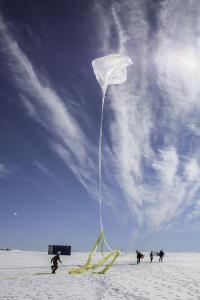In the bright, constant sun of the Antarctic summer, a NASA-funded team is launching balloons. There are twenty of these big, white balloons, each of which sets off on a different day for a leisurely float around the South Pole to collect information about something far more speedy: the rain of particles that can precipitate out of two gigantic donuts around Earth known as the radiation belts.
 "Scientists race through the Antarctic snow to launch one of 20 balloons as part of NASA's BARREL (Balloon Array for Radiation belt Relativistic Electron Losses) mission. Each balloon is equipped with instruments to help track how electrons from giant radiation belts surrounding Earth travel down magnetic field lines toward the poles."
"Scientists race through the Antarctic snow to launch one of 20 balloons as part of NASA's BARREL (Balloon Array for Radiation belt Relativistic Electron Losses) mission. Each balloon is equipped with instruments to help track how electrons from giant radiation belts surrounding Earth travel down magnetic field lines toward the poles."
The mission – called BARREL (Balloon Array for Radiation belt Relativistic Electron Losses) – is led by Dartmouth College in Hanover, N.H. BARREL works in conjunction with NASA's Van Allen Probes, two spacecraft currently orbiting around Earth to study the belts, which are also known as the Van Allen Belts. Both the probes and the belts are named after James Van Allen who originally discovered them in 1958.
Together the two missions are trying to track where radiation goes when it escapes the belts – up or down? The charged particles within the belts can damage sensitive electronics on spacecraft like those used for global positioning systems and communications, and can be harmful to humans in space. (The electrons don't make it all the way to Earth, so pose no danger to those of us on the ground.) The Van Allen Probes are observing how the particles behave in the radiation belts themselves, while BARREL can watch to see how and when the particles course down magnetic fields toward the South Pole. Working together, the two missions will track how the particles move.
"We have daily phone calls from Antarctica with the Van Allen Probes team to coordinate," says Robyn Millan, the principal investigator for BARREL at Dartmouth. "We look at where their spacecraft are relative to the balloons and make decisions about what data to download from the spacecraft to compare to our data."
After they've launched their 20 balloons, the scientists will go home to analyze the vast amount of BARREL observations and compare it to the information collected by the probes. And then the team will get ready to do the process all over again with 20 more balloons next year.
In addition to Dartmouth, the BARREL mission is supported by scientists from University of California-Berkeley, the University of Washington and University of California-Santa Cruz. Field operations are being conducted at the British research station Halley VI and the South African research station, SANAE IV. In addition to NASA and National Science Foundation support, the campaigns are supported by the National Environmental Research Council in the United Kingdom and the South African National Space Agency (SANSA).